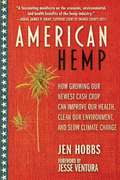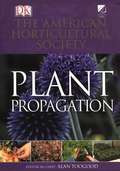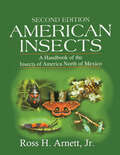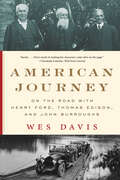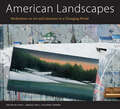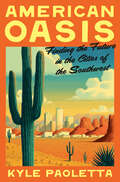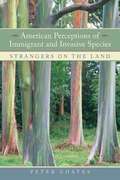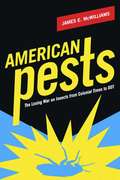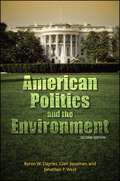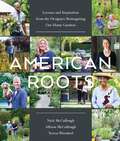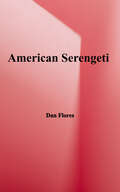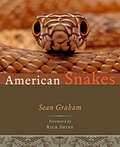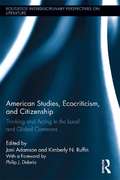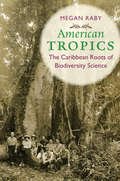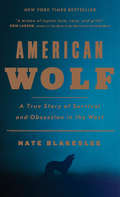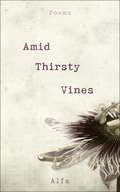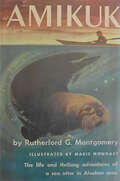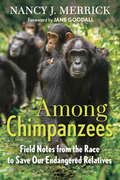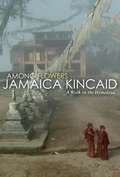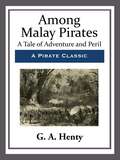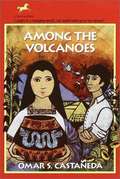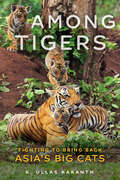- Table View
- List View
American Haven
by Elizabeth YatesTeenagers Michael and Meredith Lamb find new friends and mountains to climb when they travel from war-torn London to New Hampshire with their Uncle Tony during World War II.
American Hemp: How Growing Our Newest Cash Crop Can Improve Our Health, Clean Our Environment, and Slow Climate Change
by Jen HobbsIf there ever was a time to build an American hemp industry, the time is now.In Jesse Ventura’s Marijuana Manifesto, former Minnesota Governor teamed up with Jen Hobbs to explain why it’s time to fully legalize cannabis and end the War on Drugs. Through their research, it became clear that hemp needed its own manifesto. Jen Hobbs takes up this torch in American Hemp.December of 2018 marked a largely unprecedented victory for cannabis. The 2018 Farm Bill passed and with it hemp became legal. What the federal government listed for decades as a schedule 1 narcotic was finally classified as an agricultural crop, giving great promise to the rise of a new American hemp industry. Filled with catchall research, American Hemp examines what this new domestic crop can be used for, what makes it a superior product, and what made it illegal in the first place; the book also delves into the many health and medical benefits of the plant. Hobbs weighs in on how hemp can improve existing industries, from farming to energy to 3D printing, plus how it can make a serious impact on climate change by removing toxins from the soil and by decreasing our dependence on plastics and fossil fuels.American Hemp lays out where we are as a nation on expanding this entirely new (yet ancient) domestic industry while optimistically reasoning that by sowing hemp, we can grow a better future and save the planet in the process.
American Horticultural Society Plant Propagation
by Paul Anderson Alan ToogoodAHS Plant Propagation is a comprehensive, essential guide to increasing the numbers of a huge range of plants. An extensive introduction explains the botany and plant physiology behind the science of propagation, and the encyclopedic A - Z section presents all the appropriate techniques for more than 1,000 different kinds of plants. Specialized groups such as orchids, ferns, palms, grasses, and roses are given extensive feature treatment.
American Insects: A Handbook of the Insects of America North of Mexico, Second Edition
by Ross H. Arnett Jr.Offering a complete accounting of the insects of North America, this handbook is an up-dated edition of the first handbook ever compiled in the history of American entomology.By using American Insects, A Handbook of the Insects of America North of Mexico, Second Edition, readers can quickly determine the taxonomic position of any species, genus, or
American Journey: On The Road With Henry Ford, Thomas Edison, And John Burroughs
by Wes Davis“Jaunty.… Davis excels in making his characters come alive on the page.” —Christoph Irmscher, Wall Street Journal The epic road trips—and surprising friendship—of John Burroughs, nineteenth-century naturalist, and Henry Ford and Thomas Edison, inventors of the modern age. In 1913, an unlikely friendship blossomed between Henry Ford and famed naturalist John Burroughs. When their mutual interest in Ralph Waldo Emerson led them to set out in one of Ford’s Model Ts to explore the Transcendentalist’s New England, the trip would prove to be the first of many excursions that would take Ford and Burroughs, together with an enthusiastic Thomas Edison, across America. Their road trips—increasingly ambitious in scope—transported members of the group to the 1915 Panama–Pacific International Exposition in San Francisco, the Adirondacks of New York, and the Green Mountains of Vermont, finally paving the way for a grand 1918 expedition through southern Appalachia. In many ways, their timing could not have been worse. With war raging in Europe and an influenza pandemic that had already claimed thousands of lives abroad beginning to plague the United States, it was an inopportune moment for travel. Nevertheless, each of the men who embarked on the 1918 journey would subsequently point to it as the most memorable vacation of their lives. These travels profoundly influenced the way Ford, Edison, and Burroughs viewed the world, nudging their work in new directions through a transformative decade in American history. In American Journey, Wes Davis re-creates these landmark adventures, through which one of the great naturalists of the nineteenth century helped the men who invented the modern age reconnect with the natural world—and reimagine the world they were creating.
American Landscapes: Meditations on Art and Literature in a Changing World (University of Mississippi Museum and Historic Houses Series)
by Ann J. Abadie and J. Richard GruberAmerican Landscapes: Meditations on Art and Literature in a Changing World is a major contemporary survey of landscapes in art and literature of the United States, especially the American South. Inspired by William Dunlap’s extraordinary landscape Meditations on the Origins of Agriculture in America and a collection of forty paintings and photographs by Southern artists, this volume brings together artists, authors, and scholars to present new perspectives on art and literature both past and present. The volume includes art and text from artists John Alexander, Jason Bouldin, William Dunlap, Carlyle Wolfe Lee, Ke Francis, Linda Burgess, Randy Hayes; photographers Sally Mann, Ed Croom, and Huger Foote; museum directors Betsy Bradley, Jane Livingston, and Julian Rankin; and authors W. Ralph Eubanks, John Grisham, J. Richard Gruber, Jessica B. Harris, Lisa Howorth, Julia Reed, Natasha Trethewey, Curtis Wilkie, Joseph M. Pierce, and Drew Gilpin Faust. This diverse group explores major eras of American history portrayed in Dunlap’s painting, a landscape that evokes the displacement and genocide of Native Americans, the enslavement of Africans, the Civil War, and William Faulkner’s fiction. They examine the history of landscape art in America, connecting art with the works of major writers like William Faulkner, Eudora Welty, Natasha Trethewey, and Jesmyn Ward. In eighteen new essays written during the pandemic and since the events of January 6, 2021, the essayists emphasize how the key issues Dunlap addressed in his 1987 artwork have become part of the national discourse and make his work even more vital today.
American Oasis: Finding the Future in the Cities of the Southwest
by Kyle PaolettaAn expansive and revelatory historical exploration of the multicultural, water-seeking, land-destroying settlers of the most arid corner of North America, arguing that in order to know where the United States is going in the era of mass migration and climate crisis we must understand where the Southwest has already beenAlbuquerque. Phoenix. Tucson. El Paso. Las Vegas. Iconic American cities surrounded by desert and rust. Teeming metropolises that seem to exist independently of the seemingly inhospitable and arid landscape that surrounds them, belying the rich insight they offer into American stories of migration, industry, bloodshed, and rebirth. Charting a geographic path through America's largest and hottest deserts, acclaimed journalist Kyle Paoletta maps the past and future of these cities, and the many other settlements from rural town to urban sprawl that make up the region that has come to be called &“the American Southwest.&” Weaving together the stories of immigrants and indigenous populations, American Oasis pulls back the layers of settlement, sediment, habit, and effect that successive empires have left on the region, from the Athapascan, Diné, Tewa, Apache, and Comanche, to the Spanish, Mexican, and, finally, American. As Paoletta&’s journey into the Southwest&’s history becomes inextricably linked to an exploration of its dependency on water, he begins to ask: where, ultimately, will cities like Las Vegas and Phoenix find themselves once the Colorado River and its branches dry up? Richly reported and sweeping in its history, American Oasis is the story of what one iconic region&’s past can tell us about our shared environmental and cultural future.
American Perception of Immigrant and Invasive Species: Strangers on the Land
by Peter CoatesSetting the saga of human relations with the environment in the broad context of scientific, social, and cultural history, this thought-provoking book demonstrates how profoundly notions of nationality and debates over race and immigration have shaped American understandings of the natural world.
American Pests: The Losing War on Insects from Colonial Times to DDT
by James McWilliamsThe world of insects is one we only dimly understand. Yet from using arsenic, cobalt, and quicksilver to kill household infiltrators to employing the sophisticated tools of the Orkin Man, Americans have fought to eradicate the "bugs" they have learned to hate. Inspired by the still-revolutionary theories of Rachel Carson's Silent Spring, James E. McWilliams argues for a more harmonious and rational approach to our relationship with insects, one that does not harm our environment and, consequently, ourselves along the way. <P><P>Beginning with the early techniques of colonial farmers and ending with the modern use of chemical insecticides, McWilliams deftly shows how America's war on insects mirrors its continual struggle with nature, economic development, technology, and federal regulation. He reveals a very American paradox: the men and women who settled and developed this country sought to control the environment and achieve certain economic goals; yet their methods of agricultural expansion undermined their efforts and linked them even closer to the inexorable realities of the insect world. As told from the perspective of the often flamboyant actors in the battle against insects, American Pests is a fascinating investigation into the attitudes, policies, and practices that continue to influence our behavior toward insects. Asking us to question, if not abandon, our reckless (and sometimes futile) attempts at insect control, McWilliams convincingly argues that insects, like people, have an inherent right to exist and that in our attempt to rid ourselves of insects, we compromise the balance of nature.
American Politics and the Environment, Second Edition (SUNY Press Open Access)
by Jonathan P. West Byron W. Daynes Glen SussmanChanging our environmental policy has been at the forefront of many political discussions. But how can we make this change come about? In American Politics and the Environment, Second Edition, Byron W. Daynes, Glen Sussman and Jonathan P. West argue it is critical that we must understand the politics of environmental decision making and how political actors operate within political institutions. Blending behavioral and institutional approaches, each chapter combines discussion of an institution along with sidebars focusing on a particular environmental topic as well as a personal profile of a key decision maker. A central focus of this second edition is the emergence of global climate change as a key issue. Although the scientific community can provide research findings to policy makers, politics can create conflicts, tensions, and delays in the crafting of effective and necessary environmental policy responses. Daynes, Sussman, and West help us understand the role of politics in the policy making process and why institutional players such as the president, Congress, and interest groups succeed or fail in responding to important environmental challenges.This book is freely available in an open access edition thanks to Knowledge Unlatched—an initiative that provides libraries and institutions with a centralized platform to support OA collections and from leading publishing houses and OA initiatives. Learn more at the Knowledge Unlatched website at: https://www.knowledgeunlatched.org/, and access the book online at the SUNY Open Access Repository at http://hdl.handle.net/20.500.12648/7128.
American Roots: Lessons and Inspiration from the Designers Reimagining Our Home Gardens
by Nick McCullough Allison McCullough Teresa Woodard&“I love this book. Here are home gardens of designers from every part of our great country that are inspiring proof of a passionate vitality and freshness in American gardening today.&” — Page Dickey, author of Uprooted In recent years, bold designers have begun championing an American design aesthetic that embraces regional cultures, plants, and growing conditions. In American Roots, Nick McCullough, Allison McCullough, and Teresa Woodard highlight designers and creatives with exceptional home gardens, focused on those who push the boundaries, trial extraordinary plants, embrace a regional ethos, and express their talents in highly personal ways. Covering all the regions of the country, the profiles dive into design influences, share the back stories of the gardens and their creators, and include design tips and plant suggestions. American Roots is a beautiful invitation to reconsider how we define the American garden, filled with guidance and encouragement for anyone looking to dig more deeply into their own home garden.
American Serengeti: The Last Big Animals of the Great Plains
by Dan FloresAmerica's Great Plains once possessed one of the grandest wildlife spectacles of the world, equaled only by such places as the Serengeti, the Masai Mara, or the veld of South Africa. Pronghorn antelope, gray wolves, bison, coyotes, wild horses, and grizzly bears: less than two hundred years ago these creatures existed in such abundance that John James Audubon was moved to write, "it is impossible to describe or even conceive the vast multitudes of these animals." In a work that is at once a lyrical evocation of that lost splendor and a detailed natural history of these charismatic species of the historic Great Plains, veteran naturalist and outdoorsman Dan Flores draws a vivid portrait of each of these animals in their glory--and tells the harrowing story of what happened to them at the hands of market hunters and ranchers and ultimately a federal killing program in the nineteenth and twentieth centuries. The Great Plains with its wildlife intact dazzled Americans and Europeans alike, prompting numerous literary tributes. American Serengeti takes its place alongside these celebratory works, showing us the grazers and predators of the plains against the vast opalescent distances, the blue mountains shimmering on the horizon, the great rippling tracts of yellowed grasslands. Far from the empty "flyover country" of recent times, this landscape is alive with a complex ecology at least 20,000 years old--a continental patrimony whose wonders may not be entirely lost, as recent efforts hold out hope of partial restoration of these historic species. Written by an author who has done breakthrough work on the histories of several of these animals--including bison, wild horses, and coyotes--American Serengeti is as rigorous in its research as it is intimate in its sense of wonder--the most deeply informed, closely observed view we have of the Great Plains' wild heritage.
American Snakes
by Sean P. Graham“A wonderful book to read because it is replete with snake stories, personal stories, and stories about other herpetologists . . . engaging.” —CopeiaAlthough many people fear them, snakes are as much a part of America’s rich natural heritage as redwoods, bald eagles, and grizzly bears. Found from the vast Okefenokee Swamp to high alpine meadows, from hardwood canopies to the burning bottom of the Grand Canyon, these ultimate vertebrates are ecologically pivotal predators and quintessential survivors.In this revelatory and engaging meditation on American snakes, Sean P. Graham, a respected herpetologist and gifted writer,explains the everyday lives of American snakes, from their daily routines and seasonal cycles to their love lives, hunting tactics, and defensive repertoiresdebunks harmful myths about snakes and explores their relationship with humanshighlights the contribution of snakes to the American wildernesstells tales of “snake people”—important snake biologists with inspiring careersNeither a typical field guide nor an exhaustive reference, American Snakes is instead a fascinating study of the suborder Serpentes. Brimming with intriguing and unusual stories—of hognose snakes that roll over and play dead, blindsnakes with tiny vestigial lungs, rainbow-hued dipsadines, and wave-surfing sea-snakes—the text is interspersed with scores of gorgeous full-color images of snakes, from the scary to the sublime. This proud celebration of a diverse American wildlife group will make every reader, no matter how skeptical, into a genuine snake lover.“This thoroughly enjoyable book lets readers absorb the excitement of being a herpetologist who works with snakes while learning about the general and specific biology of the creatures.” —Quarterly Review of Biology
American Studies, Ecocriticism, and Citizenship: Thinking and Acting in the Local and Global Commons (Routledge Interdisciplinary Perspectives on Literature)
by Philip J. Deloria Joni Adamson Kimberly N. RuffinThis collection reclaims public intellectuals and scholars important to the foundational work in American Studies that contributed to emerging conceptions of an "ecological citizenship" advocating something other than nationalism or an "exclusionary ethics of place." Co-editors Adamson and Ruffin recover underrecognized field genealogies in American Studies (i.e. the work of early scholars whose scope was transnational and whose activism focused on race, class and gender) and ecocriticism (i.e. the work of movement leaders, activists and scholars concerned with environmental justice whose work predates the 1990s advent of the field). They stress the necessity of a confluence of intellectual traditions, or "interdisciplinarities," in meeting the challenges presented by the "anthropocene," a new era in which human beings have the power to radically endanger the planet or support new approaches to transnational, national and ecological citizenship. Contributors to the collection examine literary, historical, and cultural examples from the 19th century to the 21st. They explore notions of the common—namely, common humanity, common wealth, and common ground—and the relation of these notions to often conflicting definitions of who (or what) can have access to "citizenship" and "rights." The book engages in scholarly ecological analysis via the lens of various human groups—ethnic, racial, gendered, coalitional—that are shaping twenty-first century environmental experience and vision. Read together, the essays included in American Studies, Ecocriticism, and Citizenship create a "methodological commons" where environmental justice case studies and interviews with activists and artists living in places as diverse as the U.S., Canada, Haiti, Puerto Rico, Taiwan and the Navajo Nation, can be considered alongside literary and social science analysis that contributes significantly to current debates catalyzed by nuclear meltdowns, oil spills, hurricanes, and climate change, but also by hopes for a common future that will ensure the rights of all beings--human and nonhuman-- to exist, maintain, and regenerate life cycles and evolutionary processes
American Tropics: The Caribbean Roots of Biodiversity Science (Flows, Migrations, and Exchanges)
by Megan RabyBiodiversity has been a key concept in international conservation since the 1980s, yet historians have paid little attention to its origins. Uncovering its roots in tropical fieldwork and the southward expansion of U.S. empire at the turn of the twentieth century, Megan Raby details how ecologists took advantage of growing U.S. landholdings in the circum-Caribbean by establishing permanent field stations for long-term, basic tropical research. From these outposts of U.S. science, a growing community of American "tropical biologists" developed both the key scientific concepts and the values embedded in the modern discourse of biodiversity.Considering U.S. biological fieldwork from the era of the Spanish-American War through the anticolonial movements of the 1960s and 1970s, this study combines the history of science, environmental history, and the history of U.S.–Caribbean and Latin American relations. In doing so, Raby sheds new light on the origins of contemporary scientific and environmentalist thought and brings to the forefront a surprisingly neglected history of twentieth-century U.S. science and empire.
American Wolf: A True Story of Survival and Obsession in the West
by Nate BlakesleeThe enthralling story of the rise and reign of O-Six, the celebrated Yellowstone wolf, and the people who loved or feared her <P><P>Before men ruled the earth, there were wolves. Once abundant in North America, these majestic creatures were hunted to near extinction in the lower 48 states by the 1920s. But in recent decades, conservationists have brought wolves back to the Rockies, igniting a battle over the very soul of the West. With novelistic detail, Nate Blakeslee tells the gripping story of one of these wolves, O-Six, a charismatic alpha female named for the year of her birth. <P><P>Uncommonly powerful, with gray fur and faint black ovals around each eye, O-Six is a kind and merciful leader, a fiercely intelligent fighter, and a doting mother. She is beloved by wolf watchers, particularly renowned naturalist Rick McIntyre, and becomes something of a social media star, with followers around the world. <P><P>But as she raises her pups and protects her pack, O-Six is challenged on all fronts: by hunters, who compete with wolves for the elk they both prize; by cattle ranchers who are losing livestock and have the ear of politicians; and by other Yellowstone wolves who are vying for control of the park’s stunningly beautiful Lamar Valley. <P><P>These forces collide in American Wolf, a riveting multigenerational saga of hardship and triumph that tells a larger story about the ongoing cultural clash in the West—between those fighting for a vanishing way of life and those committed to restoring one of the country’s most iconic landscapes.
America’s Water Crises: The Impact of Drought and Climate Change
by David E. McNabb Carl R. SwensonThis book is focused exclusively on water problems in the 48 U.S. states. The authors provide an accessible overview of the work of many federal, state and academic researchers and water system administrators whose investigations have focused on the state of water and the water crisis now accelerating in the United States. David McNabb and Carl Swenson seek to bring to a wider audience some of the current research findings and data on the perilous state of the United States’ surface and groundwater resources during this time of climate change and the extreme drought taking place in many sections of the nation. Descriptions of the water resource systems are based on research and the subsequent findings published by water scientists in the United States Geological Survey, the Environmental Protection Agency, the U.S. Corps of Engineers and water related agencies of the Departments of Agriculture and of the Interior and state and local water management agencies.
Ami Ami Kittens: Seriously Cute Crochet!
by Mitsuki HoshiThe third colorful and imaginative installment in the illustrated amigurumi series, following Ami Ami Dogs and Ami Ami Dogs 2. Amigurumi, which translates to knitted stuffed toy in Japanese, is the art of crocheting cute stuffed animals with large heads and small bodies. Ami Ami Kittens is packed with projects for all crochet lovers offering them directions and inspiration for creating a range of fun and irresistible yarn kittens. Detailed, easy-to-follow instructions, illustrations, and enchanting color photographs teach them how to create these super adorable felines of various breeds and types, including Tabby, Pointed, Black/White Solid, Black and White, Calico, Scottish Fold, Siamese, Russian Blue, Munchkin, Maine Coon, British Shorthair, and American Shorthair. Here, too, are instructions for transforming them into key chains, finger puppets, and magnets. Ami Ami Kittens covers a wide range of techniques, from basic crochet skills perfect for beginners to more challenging patterns for experts, and offers spiral methods to ensure that the stuffing stays inside the finished piece. Filled with pretty, fun, and irresistibly adorable young cats, Ami Ami Kittens provides hours of fun for every knitter-and cat lovers, too.
Amid Thirsty Vines: Poems
by AlfaThemes of self-discovery, tending the garden of the soul, and nurturing yourself into blossom, Amid Thirsty Vines by Instagram poetry star Alfa is the collection you need to feel the power of the beautiful flowers within you, and to find the love you deserve. This volume belongs in the collection of every modern poetry fan.
Amikuk
by Rutherford MontgomeryTHIS IS a tale of adventure in the seas around the Aleutian Islands, seas that are populated by sharks and sea lions, whales and porpoises—and sea otters. Amikuk is a young sea otter. As he grows up and learns to swim and dive for his own food, he also learns that the life of a sea otter is full of dangers—from men who will stop at nothing to gain his valuable pelt, from killer whales, and from deadly sharks. In this exciting and unusual story, Amikuk learns to take care of himself in dangerous waters, and—with the help of an unknown friend, an Aleutian boy named Peter—manages to escape from the clubs and bullets of determined hunters. It is Peter who saves Amikuk and his family from certain death more than once—although the otters never know of Peter's guardianship of their lives. Woven into the story are the excitement of a shipwreck, a thrilling contest between a small band of men and a herd of huge sea lions, Amikuk's narrow escapes from sea marauders. All in all, this is a book that will delight all youthful readers.
Among Chimpanzees
by Jane Goodall Nancy J. MerrickA former student and colleague of Jane Goodall shares stories of chimps and their heroes, and takes readers on a journey to save man's closest relative. Unbeknownst to much of the public, chimps are in trouble: censuses show them to be extinct in four African countries and nearly so in ten others. A large percentage of the remaining populations live in unprotected, increasingly fragmented forests. When Nancy Merrick learned these startling facts in 2009, she decided it was past time to discover the extent to which chimpanzees are at risk across Africa and what can be done. Merrick had begun working with primates in 1972 as a young field assistant in Jane Goodall's famous Gombe camp. Like the rest of the world at the time, she was swept up in the excitement of discovering the remarkable world of chimpanzees--their ability to fashion tools, their dazzling intelligence, and their complex relationships and societies. From that moment on, her human-centered worldview shifted, and she became a devoted advocate for our closest genetic relatives. When Merrick returns to Africa decades later, she's alarmed by how much has changed. Human activity, such as agriculture and logging, has encroached on natural habitats throughout equatorial Africa, endangering chimpanzees, gorillas, and bonobos. In an effort to understand what we can do to save great apes, Merrick connects with primatologists and conservationists who are trying to protect the last great forests. Visits to some of Africa's parks, sanctuaries, and expanding agricultural areas reveal the urgency of the problems and the inspiration of the people leading the search for solutions. Along the way, Merrick demonstrates that the best hope for chimps and other great apes lies in connecting conservation to humanitarian efforts, ensuring a healthy future for animals and humans alike. Among Chimpanzees is at once an inspiring chronicle of Merrick's personal search to learn how chimps are faring across Africa and in captivity, a crucial eyewitness account of a very critical period in their existence, and a rousing call for us to join the efforts to be a voice for the chimpanzees, before it's too late.From the Hardcover edition.
Among Flowers: A Walk in the Himalaya
by Jamaica KincaidAnyone familiar with Jamaica Kincaid's work knows that the natural world and in particular, plants and gardening are especially close to her heart. In this vivid account she invites us to accompany her on a seed-gathering trek in the Himalaya. For Kincaid and three botanist friends, Nepal is a paradise a place where a single day's hike can traverse climate zones from sub-tropical to alpine encompassing flora suitable for growing in their home grounds from Wales to Vermont. A wonderful blend of introspective insight and beautifully rendered description, Among Flowers is a seriously entertaining thoroughly engaging and characteristically frank memoir from one of the most distinctive and striking voices writing today.
Among Malay Pirates
by G. A. HentyAmong Malay Pirates is a story of courage and danger. Join our heroes as they pit themselves against blood thirsty pirates and epic sea storms. A magnificent swashbuckling story of a grander more adventurous time.
Among The Volcanoes
by Omar CastañedaIsabel Pascay longs to go to school and become a teacher, but her dream just doesn't seem possible in the small Guatemalan village where she lives. The villagers expect Isabel to follow tradition and marry her boyfriend, handsome Lucas Choy. And her mother is ill, but resists Western medicine, relying on a local healer. As the eldest daughter, all the family burdens seem to fall on Isabel. Can she hold on to her dreams for the future and achieve her goal?
Among Tigers: Fighting to Bring Back Asia's Big Cats
by K. Ullas KaranthToday ten times more tigers live in captivity than survive in the wild. For over five decades, K. Ullas Karanth has been engaged in the struggle to bring wild tigers back from the brink in India, their last remaining wild stronghold. He tells the story of the tiger itself—its incredible biology, its critical role in shaping natural ecosystems of Asia, and the unique place it holds in our collective imagination.Among Tigers is the story of how we wound up with fewer than 5,000 wild tigers, and how, with focused efforts we can grow that population ten times or more in a few decades. In doing so, we would bring not only the world's largest and most beloved feline back from the brink, but also save countless other species that share the tigers habitats from the freezing forests of Siberia to the tropics of India. Karanth shares the adventurous real-life story of his quest to save a species and, along the way, the hopeful realization that tiger conservation is a battle that can be won.Ultimately, the book is a roadmap showing us how to not only to save the greatest of great cats, but to bring it roaring back at numbers never before seen in our lifetimes.

